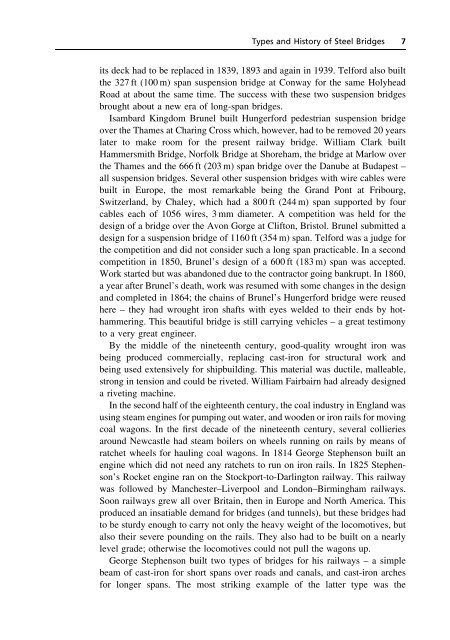The Design of Modern Steel Bridges - TEDI
The Design of Modern Steel Bridges - TEDI
The Design of Modern Steel Bridges - TEDI
You also want an ePaper? Increase the reach of your titles
YUMPU automatically turns print PDFs into web optimized ePapers that Google loves.
Types and History <strong>of</strong> <strong>Steel</strong> <strong>Bridges</strong> 7<br />
its deck had to be replaced in 1839, 1893 and again in 1939. Telford also built<br />
the 327 ft (100 m) span suspension bridge at Conway for the same Holyhead<br />
Road at about the same time. <strong>The</strong> success with these two suspension bridges<br />
brought about a new era <strong>of</strong> long-span bridges.<br />
Isambard Kingdom Brunel built Hungerford pedestrian suspension bridge<br />
over the Thames at Charing Cross which, however, had to be removed 20 years<br />
later to make room for the present railway bridge. William Clark built<br />
Hammersmith Bridge, Norfolk Bridge at Shoreham, the bridge at Marlow over<br />
the Thames and the 666 ft (203 m) span bridge over the Danube at Budapest –<br />
all suspension bridges. Several other suspension bridges with wire cables were<br />
built in Europe, the most remarkable being the Grand Pont at Fribourg,<br />
Switzerland, by Chaley, which had a 800 ft (244 m) span supported by four<br />
cables each <strong>of</strong> 1056 wires, 3 mm diameter. A competition was held for the<br />
design <strong>of</strong> a bridge over the Avon Gorge at Clifton, Bristol. Brunel submitted a<br />
design for a suspension bridge <strong>of</strong> 1160 ft (354 m) span. Telford was a judge for<br />
the competition and did not consider such a long span practicable. In a second<br />
competition in 1850, Brunel’s design <strong>of</strong> a 600 ft (183 m) span was accepted.<br />
Work started but was abandoned due to the contractor going bankrupt. In 1860,<br />
a year after Brunel’s death, work was resumed with some changes in the design<br />
and completed in 1864; the chains <strong>of</strong> Brunel’s Hungerford bridge were reused<br />
here – they had wrought iron shafts with eyes welded to their ends by hothammering.<br />
This beautiful bridge is still carrying vehicles – a great testimony<br />
to a very great engineer.<br />
By the middle <strong>of</strong> the nineteenth century, good-quality wrought iron was<br />
being produced commercially, replacing cast-iron for structural work and<br />
being used extensively for shipbuilding. This material was ductile, malleable,<br />
strong in tension and could be riveted. William Fairbairn had already designed<br />
a riveting machine.<br />
In the second half <strong>of</strong> the eighteenth century, the coal industry in England was<br />
using steam engines for pumping out water, and wooden or iron rails for moving<br />
coal wagons. In the first decade <strong>of</strong> the nineteenth century, several collieries<br />
around Newcastle had steam boilers on wheels running on rails by means <strong>of</strong><br />
ratchet wheels for hauling coal wagons. In 1814 George Stephenson built an<br />
engine which did not need any ratchets to run on iron rails. In 1825 Stephenson’s<br />
Rocket engine ran on the Stockport-to-Darlington railway. This railway<br />
was followed by Manchester–Liverpool and London–Birmingham railways.<br />
Soon railways grew all over Britain, then in Europe and North America. This<br />
produced an insatiable demand for bridges (and tunnels), but these bridges had<br />
to be sturdy enough to carry not only the heavy weight <strong>of</strong> the locomotives, but<br />
also their severe pounding on the rails. <strong>The</strong>y also had to be built on a nearly<br />
level grade; otherwise the locomotives could not pull the wagons up.<br />
George Stephenson built two types <strong>of</strong> bridges for his railways – a simple<br />
beam <strong>of</strong> cast-iron for short spans over roads and canals, and cast-iron arches<br />
for longer spans. <strong>The</strong> most striking example <strong>of</strong> the latter type was the


